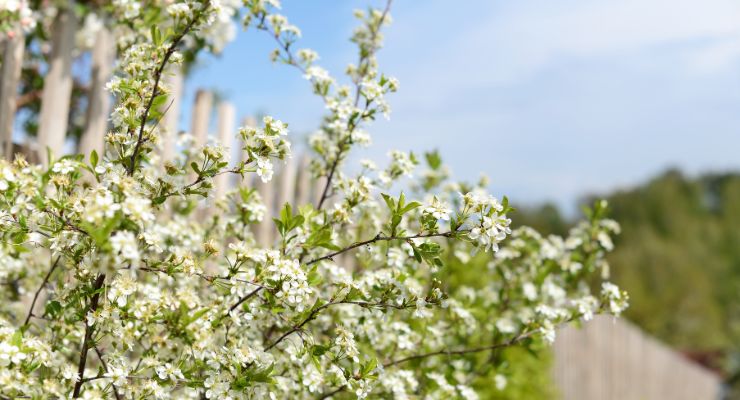White flowering shrubs are a type of shrub that produce white or cream-colored blooms. These shrubs come in a wide variety of sizes, shapes, and textures, and can be used in a variety of landscaping and gardening applications.
White flowering shrubs are highly valued in landscaping and gardening for several reasons. First, they provide a beautiful contrast against green foliage and other colorful flowers, making them an excellent choice for creating visual interest in a garden or landscape.
White flowers can also brighten up shady areas and bring a sense of elegance and sophistication to any design.
In addition to their aesthetic appeal, white flowering shrubs can also attract pollinators such as bees and butterflies to a garden. This can be especially important for gardeners who are interested in creating a wildlife-friendly landscape that supports local ecosystems.
Finally, many white flowering shrubs are easy to care for and can thrive in a wide range of growing conditions. This makes them an excellent choice for both novice and experienced gardeners who want to add beauty and interest to their outdoor spaces.
Azaleas (Rhododendron Spp.)
Azaleas are a well-known type of rhododendron that are highly valued for their spectacular flowering display and shade tolerance. These woody, evergreen shrubs belong to the Ericaceae family and produce white bell shaped flowers containing 10 or more stamens.
Native to the United States, azaleas can thrive in USDA hardiness zones 5-9 and come in different types with varying characteristics such as size, leaf shape, flower color, and number of stamens.
To care for azaleas, it is important to keep in medium moisture soil, without letting it dry out completely or become overly wet. Applying a 3-inch layer of organic mulch can help retain soil moisture and regulate soil temperature.
Pruning should be done after the blooming period to maintain a compact appearance or promote bushier growth. Feeding should be reduced after midsummer, and watering should also be reduced in early fall to prepare the plant for winter.
Azalea’s flowers bloom in early spring to fall and require a location with morning sun and afternoon shade, moist but well-drained soil, fertilization right after flowers die, and pruning as needed.
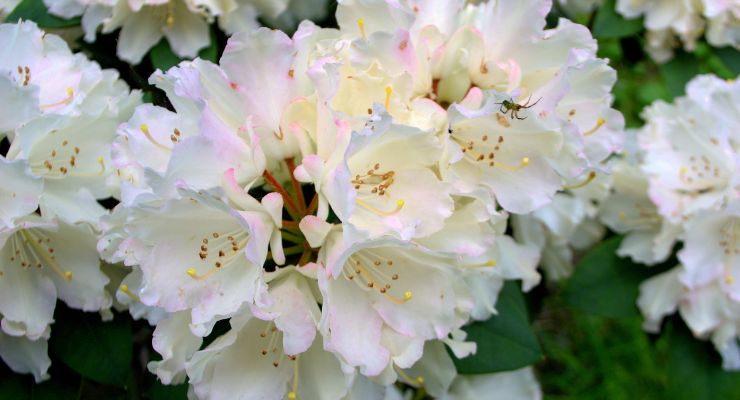
Japanese Camellia (Camellia japonica)
The Japanese camellia, or Camellia japonica, are native white flowering woody evergreen shrubs of China and Japan, often associated with adoration, longing, and eternal love. Their flower parts are believed to symbolize a noble spirit, modesty, and faithfulness.
Typically growing to 6-12 feet tall, Japanese camellia has oval, leathery, glossy leaves and is winter hardy, making it suitable for year-round outdoor cultivation in the southeastern US and Pacific coast areas. In fact, it is even the state flower of Alabama. Some cultivars can be trained to grow as an espalier specimen against a wall or fence.
To thrive, Camellia japonica prefers shade to part-shade, with some protection from winter winds, and well-drained soils that are high in organic matter and slightly acidic.
Applying a root mulch of leaves or shredded bark around the base of the plant can help retain moisture and suppress weeds. Japanese camellia requires only extra attention during times of extreme drought or when freshly planted.
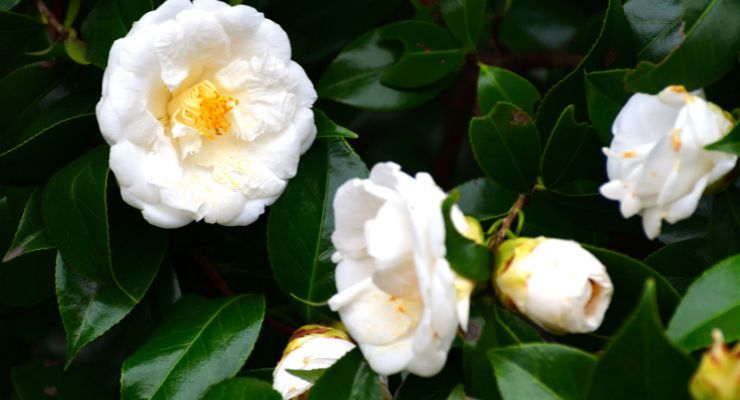
Hydrangea (Hydrangea Spp.)
Hydrangeas are a diverse genus of over 75 species of deciduous shrubs that originate from Asia and the Americas. Their light brown bark and opposite, simple leaves with toothed or lobed margins give them a unique appearance.
Hydrangeas bloom from midsummer to fall, producing immense ball-shaped clusters of flowers that add old-fashioned elegance to any garden. Growing and caring for hydrangeas is relatively simple, requiring well-draining soil and partial shade, with regular but not excessive watering.
Pruning should only be done when necessary after the blooming season. The best time to plant this white flowering shrub varies depending on the region, with planting recommended for early spring or early fall in areas with winter freezing and snow, and a longer planting window in warmer regions with mild winters, from fall to early spring.
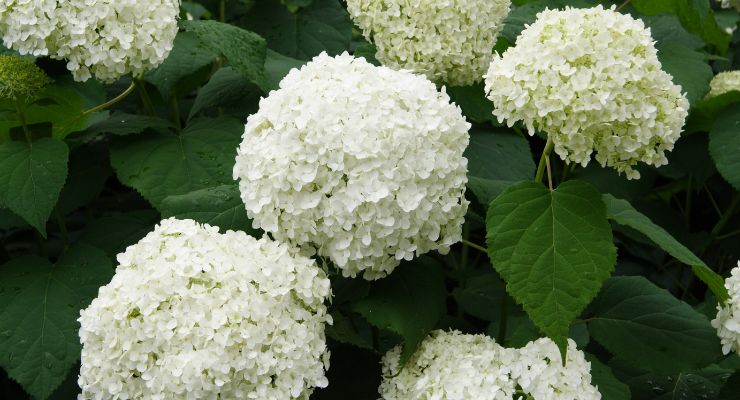
Common Lilac (Syringa vulgaris)
The Common lilac (Syringa vulgaris) is a fragrant, deciduous shrub that produces beautiful blooms in the spring. For optimal growth and development, lilacs require full sun exposure, meaning at least six hours of direct sunlight each day.
They thrive in well-drained soil with a neutral or slightly alkaline pH and should be planted in elevated areas to promote good drainage. Lilacs also require a minimum of one inch of water per week during the hottest months to ensure healthy growth.
It is recommended to prune lilac bushes every year after blooming, removing any dead wood, cutting back weak branches, and removing small suckers. Early spring is the best time to fertilize with phosphorus and potassium-rich fertilizer to promote healthy growth and blooming.
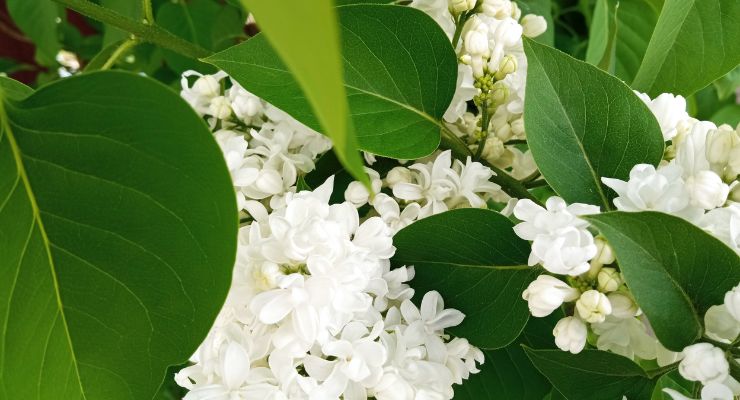
Rose of Sharon (Hibiscus syriacus)
The Rose of Sharon (Hibiscus syriacus) is a deciduous shrub or small tree that belongs to the Malvaceae family and is native to South China and Taiwan.
This plant has a vigorous, vase-shaped growth habit, and its large, showy flowers resemble hollyhock blossoms. It blooms in the late summer after most other bushes with white flowers have finished flowering, with the popular varieties starting in July and continuing into fall.
To grow a healthy Rose of Sharon plant, it is recommended to plant it in a location with full sun to partial shade and well-draining soil. These white flowering bushes are not particular about soil type or pH, and they prefer moist soil, so watering regularly is important, especially during hotter weather, and up to twice a day if in a container. Water deeply but less frequently to encourage deep, healthy roots.
In early spring, it is recommended to fertilize the Rose of Sharon with a granular rose fertilizer according to the label, with a slow-release, high potash formula such as rose food. To protect the roots from winter cold and maintain soil moisture, mulch in autumn.
After flowering, prune one-third of the oldest stems each year to promote new growth and maintain a tidy appearance.
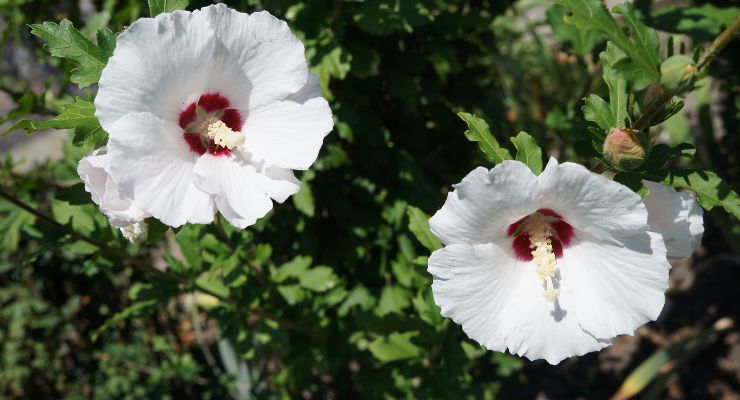
Summersweet Clethra (Clethra alnifolia)
Summersweet clethra (Clethra alnifolia) is a deciduous shrub that can be found in swampy woodlands, wet marshes, stream banks, and seashores from Maine to Florida and west to Texas, often in sandy soils.
This versatile plant offers year-round interest with shiny green leaves in spring, spiky and sweet-smelling white or pink flowers from early summer, yellow fall foliage, and attractive bark in winter. Summersweet clethra attracts hummingbirds and butterflies and can grow up to 5 to 10 feet tall, forming mounded clumps.
Once established, these bushes with white flowers require minimal care and can adapt to a variety of soil types, pH levels, and moisture levels. Water regularly to keep the soil moist, particularly during the first growing season.
Once the roots have established, summersweet clethra is somewhat drought-tolerant. It can tolerate full sun to full shade, but it grows best in light, filtered shade with morning sun and afternoon shade. Since the shrub blooms on new growth, pruning can be done at any time without damaging the plant.
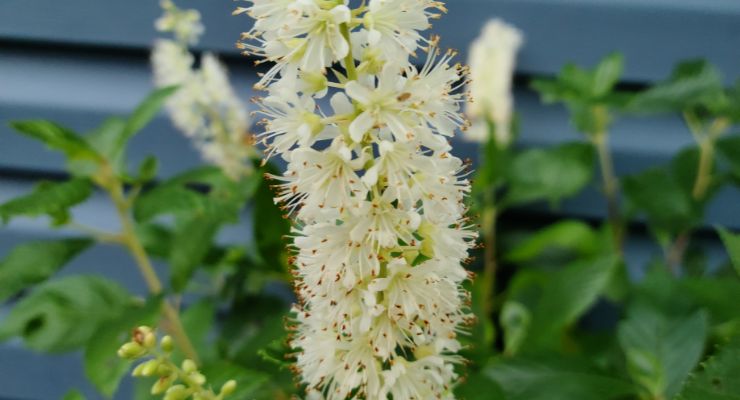
Chokeberry (Aronia arbutifolia)
Red chokeberry (Aronia arbutifolia) is a deciduous shrub that provides multi-season interest and is native to Eastern Canada and North America.
This tall, multi-stemmed, semi-evergreen shrub adds beauty to the landscape with its white, flat-topped clusters of flowers in the spring and attractive red fruit in the fall. It grows up to 6-12 ft. tall and is ideal for forest edges, bird gardens, or rain gardens. Chokeberry is generally pest and disease-free and is also deer-resistant.
To care for this white flowering shrub, keep the soil evenly moist until the plant is established. Mature plants prefer moderate water but are tolerant of both drought and excessive moisture. Regular watering is recommended for maximizing fruit production, especially during extreme heat or prolonged dry spells.
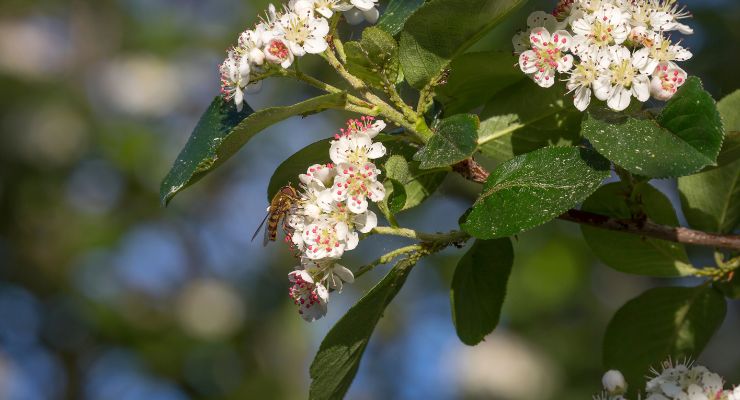
White Winter Daphne (Daphne odora ‘Aureomarginata Alba’)
White winter daphne is an attractive shrub with fragrant white tubular flowers that bloom along the branches from late winter to early spring. Its glossy, narrow leaves edged in white are highly ornamental and its dark green foliage remains throughout the winter season. The ideal time to plant this shrub in the US is in spring or early fall.
White winter daphne is low maintenance and generally does not require pruning except for shaping branches or forcing early bloom for indoor plants in winter. It prefers well-drained soil with plenty of compost and a slightly acidic pH.
Moist soil is essential for its growth and development, so ensure that the soil is consistently moist but not waterlogged. Rooted cuttings may take up to two years to mature and be ready for transplanting.
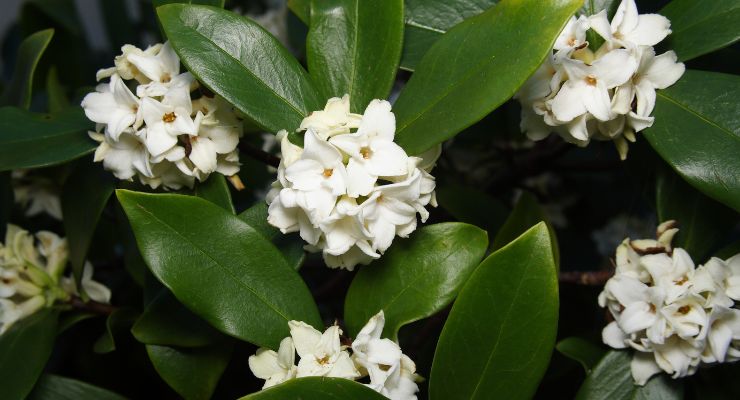
Dwarf Deutzia (Deutzia gracilis ‘Nikko’)
Dwarf deutzia (Deutzia gracilis ‘Nikko’) is a compact shrub with arching branches that are highlighted by white double blooms in spring and turn a deep burgundy in fall. It makes a lovely addition to sunny shrub borders.
For optimal growth, plant dwarf deutzia in full sun and in humusy, moist, well-drained, loamy soil. Water deeply and regularly during the first growing season and feed with a general-purpose fertilizer before new growth begins in spring.
Once established, reduce the watering frequency as the plant can tolerate mild drought. To encourage more profuse blooming, prune just after the flowers fade since the buds are set on the previous year’s growth. Periodic thinning of stems will improve air circulation and promote new growth from the base.
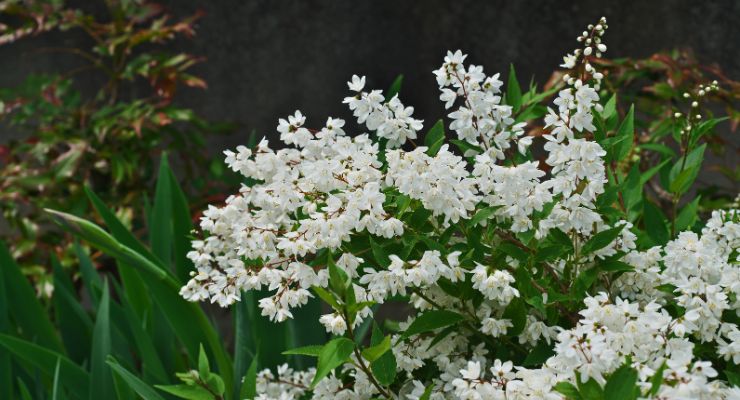
White rose (Rosa alba)
The White rose (Rosa alba) is a deciduous shrub that can thrive in various conditions, but it does best in an open area with full sun exposure and moderately fertile, humus-rich, well-drained soil.
When watering, it’s best to water deeply and less frequently to thoroughly saturate the root ball. The shrub blooms on old wood, so pruning should be done after flowering. During the first year of growth, remove unripe and damaged shoots.
From the second year onwards, cut back new basal growths by up to one-third. It’s recommended to deadhead all roses weekly to promote new shoots and more fragrant flowers.
For optimal flowering, apply a balanced fertilizer and mulch in late winter or early spring. The White rose has various cultivars, such as ‘Alba Semiplena,’ which produces semi-double white flowers with grey-green foliage and can grow up to 2.5 meters tall.
Another cultivar is ‘Alba Maxima,’ which produces flat double creamy white flowers with gray-green leaves and can grow upright up to 7 feet tall.
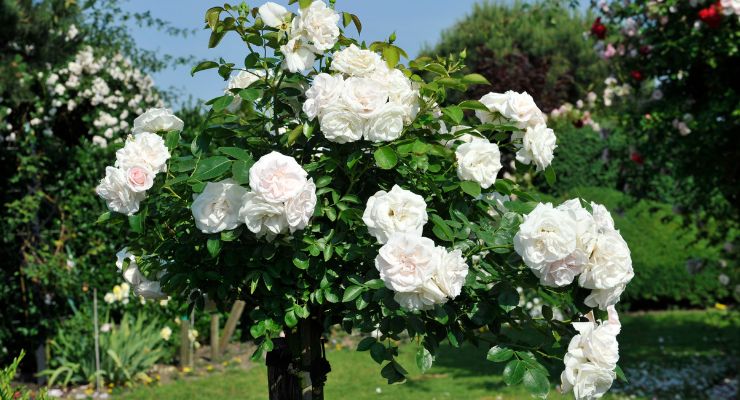
Button Bush (Cephalanthus occidentalis)
Buttonbush (Cephalanthus occidentalis) is a native shrub with unique spherical blooms composed of tiny white or pale-pink tubular flowers that attract various pollinators, including butterflies.
This deciduous shrub has an open-rounded habit, typically reaching 6-12′ tall, making it an attractive ornamental plant. The glossy green leaves emerge and unfold in the late spring, making it one of the last shrubs to leaf out in North America.
Buttonbush thrives in wet soils and is suited for low-lying areas such as bioswales, bogs, ponds, and stream banks. It is also a beneficial honey plant and a source of food for ducks and other water birds.
To grow a healthy buttonbush, plant it in full sun to partial shade in moist to wet soils. Fertilize it yearly with a slow-release fertilizer in the spring to encourage growth, especially in nutrient-rich soil.
Buttonbush is a hardy plant and can tolerate a wide range of soil conditions, including very wet conditions. To prevent it from outgrowing its space, it is recommended to cut it back every 2-3 years to reduce its height or limb up.
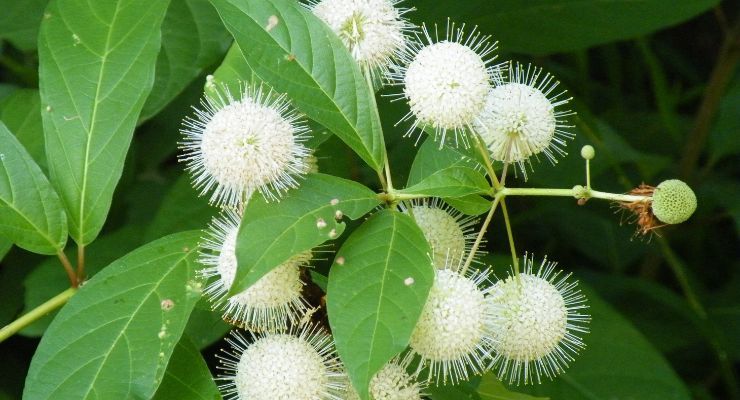
Korean Spice Viburnum (Viburnum carlesii)
Korean spice viburnum (Viburnum carlesii) is a deciduous shrub that boasts a spreading, multi-stemmed growth habit and produces wonderfully fragrant flowers, making it an ideal choice for showcasing in the spring. The oval, dark green leaves have serrated edges.
While it is a slow-growing shrub that typically reaches a height of 4-5′, it may grow as tall as 8′ over time. Korean spice viburnum thrives in moist, well-drained soil that includes clay and prefers sun to partial shade.
Its large clusters of waxy pink flowers have a spicy scent and fade to white, and its bright red berries turn black in the fall. In autumn, the foliage takes on red and burgundy hues.
The best time to plant Korean spice viburnum is in the spring after overwintering it in a sheltered spot. Water management is crucial during transplanting to ensure survival.
The newly transplanted plants must receive continuous irrigation for 3-4 weeks to keep the soil moist. Korean spice viburnum prefers moist, well-drained soil that includes clay and grows well in sun to partial shade. Pruning should be done in the spring, immediately after flowering has ended.
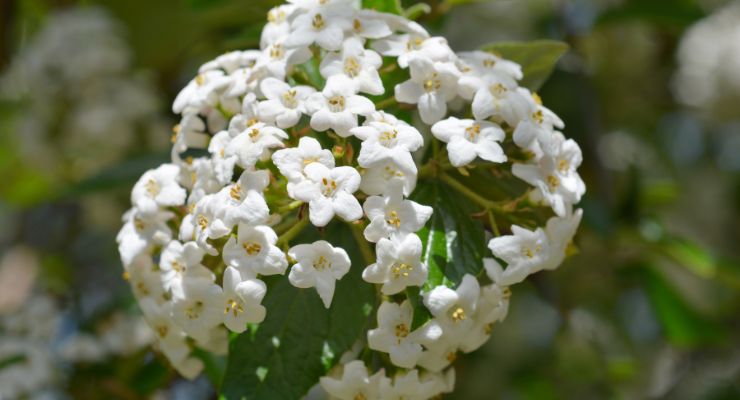
Virginia Sweetspire (Itea virginica)
The Virginia Sweetspire (Itea Virginica) is a deciduous shrub with a slender-branched, mound-shaped form that can reach up to 10 feet tall and is commonly found in streambanks and wet pine barrens in the southeastern United States. Its arching branches bear small white flowers that grow in drooping 4-inch spires.
To thrive, Virginia Sweetspire prefers slightly acidic, moist, and rich humusy soils and full sun, although it can tolerate partial shade. However, flowering may be limited, and autumn color muted in shady conditions.
Virginia Sweetspire is an excellent addition to wildlife gardens, as it provides nesting and shelter for wildlife, as well as food for bees, butterflies, and moths.
The fragrant white flowers attract pollinators, including butterflies, and make them hummingbird magnets. Birds also consume the seeds, making them an essential food source for them.
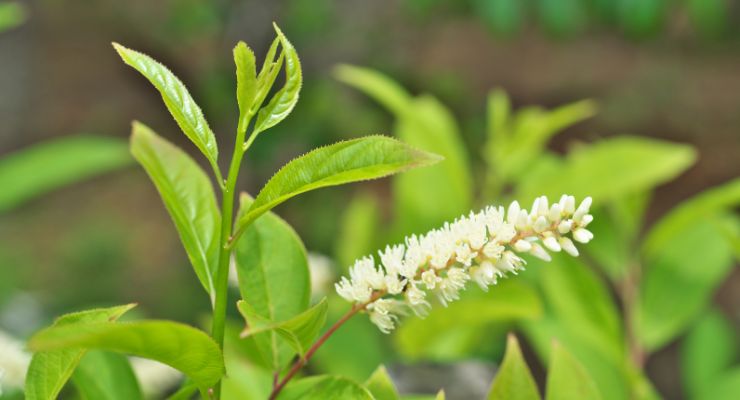
Tea Olive (Osmanthus fragrans)
Tea olive (Osmanthus fragrans) can thrive in partial shade, but too much sun may cause leaf discoloration in certain varieties. It prefers fertile, well-drained, acidic soil and can tolerate moderate drought once established.
When planting tea olive, it is important to position the top of the root ball level with the ground and water deeply to ensure the roots are well soaked. Typically, tea olives do not require pruning as they naturally form an attractive shape.
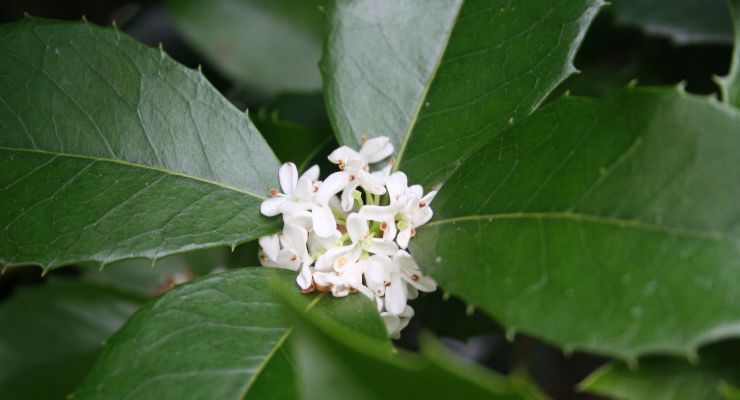
Bridal wreath spirea (Spiraea prunifolia)
The deciduous Bridal Wreath Spirea (Spiraea prunifolia) is a shrub with arching branches that can spread up to 8 feet in both height and width. In mid-spring, the shrub produces thick clusters of three to six showy, double white flowers, making it a popular choice for its beautiful spring blooms and vibrant fall foliage.
For optimal growth, Bridal Wreath Spirea prefers well-drained, moist soil with good drainage and average moisture, and it can tolerate occasional drought. It thrives in full sun to partial shade, requiring a minimum of six hours of sunlight per day and benefiting from afternoon shade.
Although not essential, pruning can enhance the shrub’s growth and flowering by cutting back any overhanging vegetation that shades the spireas, as they bloom from flower buds that form on the branches.
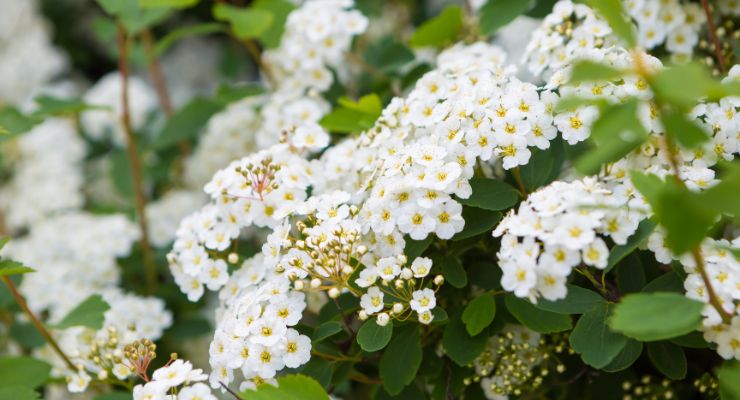
Conclusion of White Flowering Shrubs
In conclusion, white flowering shrubs offer numerous benefits for landscaping and gardening projects. These shrubs add visual interest to a garden, attract pollinators, and brighten up shady areas. Some popular examples of white flowering bushes include Hydrangea, Azalea, Rose of Sharon, and Chokeberry.
However, it is important to select the right shrub for the right location and purpose to ensure it thrives in its intended environment. Factors such as soil type, sun exposure, and water requirements should be taken into consideration when choosing a white flowering shrub.
By selecting the appropriate shrub, gardeners, and landscapers can create a beautiful and sustainable outdoor space that is both attractive and functional.
If you’re looking for flowering bushes in other colors, take a look at our articles on yellow and purple shrubs that we’ve previously covered.
